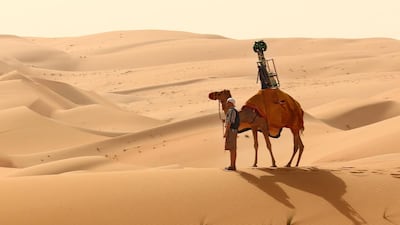ABU DHABI // Most images for Google Street View are collected with a car, but for the first time, the task was given to an animal – a 10-year-old camel named Raffia.
Raffia walked through the desert around Liwa Oasis with a Street View camera mounted on top of her hump to create panoramic views for internet users around the world.
The images, now available online, show scenery from Liwa including dunes, the oasis, other camels and Raffia's footprints and shadow.
Google has taken the Street View cameras on boats and even underwater, but this is the first time the tech company has used an animal, said Joyce Baz, spokeswoman for Google in the Middle East and North Africa.
“With every environment and every location, we try to customise the capture and how we do it for that part of the environment.
“In the case of Liwa we fashioned it in a way so that it goes on a camel so that it can capture imagery in the best, most authentic and least damaging way,” said Ms Baz.
Utilising the desert’s ancient mode of transport, an Indian guide walked the camel from as early as 6am to photograph the area in the clearest weather conditions possible, said Ms Baz.
Street View, launched in 2007, now not only collects 360-degree views of streets, but also heritage sites and other landmarks on seven continents.
It has images from 59 countries, covering a distance of more than five million miles.
Google typically uses a camera attached to a car for photographing streets, but to capture Liwa, it used the Trekker, a camera that is more than a metre high and can sit in a backpack, said Ms Baz.
The Trekker is often used for places inaccessible by car, such as narrow alleyways.
Street View photographers take the weather and time of day into account in deciding when to capture the images.
Photos are then stitched together to create the panoramic image that users can virtually navigate.
This is the third Street View available in the UAE, following the Sheikh Zayed Grand Mosque in Abu Dhabi and the Burj Khalifa in Dubai.
Street Views are also available from locations in Egypt, Israel and Turkey, as well as the Grand Canyon in the US and the Galapagos Islands in the Pacific Ocean.
Ms Baz said the feature could help boost tourism for Liwa.
“Twenty to 30 per cent of the views come from outside the country,” she said.
“We think this really helps people check these locations out before they come to visit.
“Liwa is a highly touristic site and is growing in popularity.”
Google hopes to bring Street View to more countries in the region, she said, as well as more locations in the UAE. They are in the process of capturing Dubai, said Ms Baz. “Ideally, we want to capture all of the UAE,” she said.
The company hoped to bring Street View to other countries in the region as well, said Ms Baz.
“We want obviously all countries, because there is so much history and culture and heritage,” she said.
“I think it’s just a matter of time before we move to the other countries in the Middle East.”
Liwa Oasis lies in the south west of Abu Dhabi emirate, about 100 kilometres south of the Arabian Gulf coast, at the edge of the Empty Quarter.
lcarroll@thenational.ae

